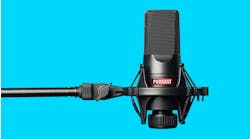This article covers the use, installation techniques, and a few NEC guidelines for electrical metallic tubing (EMT).
EMT is one of the essential wiring methods for all electricians. This raceway type is used and approved in almost every "special occupancy" (non-residential buildings) application in Chapter 5, single- and multi-family dwelling units. It is an unthreaded thin wall raceway permitted to be used for exposed, concealed, interior, and exterior use. Its primary function is to provide physical protection for conductors or cables (approved to be run in a raceway).
When EMT is installed with the proper fittings, the raceway/conduit system can also serve as the equipment grounding conductor for the branch circuits within it. In some cases, the installer does not have to run a separate green grounding conductor, which is why all fittings and connectors need to be “made up tight" or ironclad tight.
EMT is typically made of steel (ferrous) with protective coatings or aluminum (nonferrous). Available in 10-ft. or 20-ft. sections in trade sizes from 1/2 in. to 4 in., it can help reduce electromagnetic field levels of encased power distribution circuits, which shields computers and other sensitive electronic equipment from the effects of electromagnetic interference.
The tubing is required to be clearly and durably marked at least every 10 ft. with the following information:
- A UL listing mark
- Product identity type
- Manufacturers' name
- UL control number
- Batch number
EMT is available in red, white, blue, green, yellow, orange, purple, and black. This helps instantly identify different circuit systems. This color system can also eliminate the unnecessary labor and time of applying spray paints or tapes in the field. In addition, colored EMT raceway systems help building inspectors, electricians, and maintenance technicians separate and identify fire alarm circuits from power and control circuits during routine maintenance and emergencies.
The NEC does not require or designate any color for EMT raceway systems, but there is an established trade practice that you may see used in the field.
- Fire alarm (red EMT)
- Healthcare (green EMT)
- Datacom (blue EMT)
Ferrous or nonferrous EMT, elbows, couplings, and fittings shall be permitted to be installed in concrete, in direct contact with the earth, or areas subject to severe corrosive influences. However, they must be coated or protected to resist corrosion and approved to be embedded in concrete. Electricians installing EMT raceways should avoid contact with dissimilar metals. This will reduce or eliminate the possibility of galvanic action. Galvanic action (accelerated corrosion) may occur if two dissimilar metals are in contact with each other for an indefinite amount of time (e.g., permanent installations).
Water and moisture can create a conductive path between the two raceways or metals. The electrons and ions move from one metal conduit to another; one metal begins to corrode as its ions are deposited onto the other metal, keeping dissimilar metals insulated from each other. Therefore, it is only permissible to make splices, taps, or install devices within EMT fittings if the manufacturer legibly and durably marked the body with the total volume on the fitting.
Securing and supporting the raceway
Keep these spacing requirements in mind:
- EMT is required to be securely fastened, strapped, or supported at least every 10 ft.
- EMT is required to be securely fastened, strapped, or supported within 3 ft. of each conduit termination at an outlet box, junction box, device box, cabinet, or conduit body.
There are exceptions to these support requirements under specific conditions (Sec. 358.30):
Exception No. 1: Fastening of unbroken lengths shall be permitted to be increased to 5 ft. where structural members do not readily permit fastening within 3 ft.
Exception No. 2: EMT in unbroken lengths shall be permitted to be fished in concealed work in finished buildings or prefinished wall panels where such securing is impracticable.
Filling the raceway
When installing the same size conductors in a conduit, the permissible number of conductors installed in EMT shall not exceed the percentage fill in Table 1, specified in Chapter 9 or the tables in Annex C. When installing conductors of different sizes and insulation types in EMT, the combined approximate square inch area of conductor is found at Table 5.
Bending the raceway
Bending raceways requires a lot of patience, practice, and good hand/eye coordination — it’s an art form. This skill cannot be developed overnight. Always remember that between pull points, conduit bodies, and boxes, there shall not be more than 360° in a conduit run. This is the equivalent of four quarter bends 360°. Bends in the conduit or raceway shall be made so that the conduit is not damaged or pinched; you cannot reduce the internal diameter of the raceway when creating bends and offsets.
Typically, EMT is bent manually in the field using a hand bender. Although the size of a hand bender can range from 1/2 in. to 1 1/4 in., raceway sizes larger than this typically require a mechanical or hydraulic bender.
A Note from the Author
The ambitious apprentice should never forget that no matter what sector of the electrical industry you work in (e.g., commercial, industrial, maintenance, or construction), apprentices and journeymen that can bend pipe are indispensable. Most contractors would sacrifice a truck full of apprentices to get one good pipe bender.
If you are applying for a facility maintenance job, some employers may ask you to complete some simple bending tasks as part of the interview process. In some cases, if work gets slow, and the company must do layoffs, the boss will likely keep the employee skilled in pipe bending on staff, even if he must pay him/her his full rate to keep the shop organized until new work comes in. The boss is less likely to risk losing an apprentice or journeyman that is skilled at pipe bending.
Learning this craft can offer you some job security, opportunities, and advancement. Invest the time into learning how to bend conduit, even if you must practice on your own time and at your own expense.




